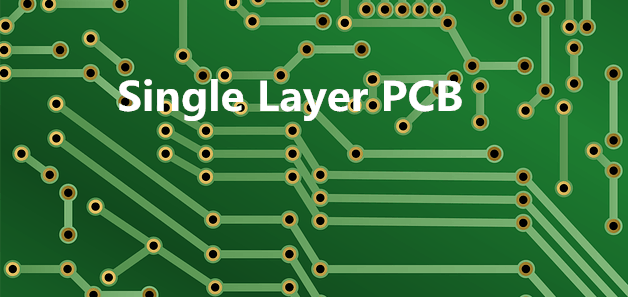Single layer printed circuit boards are a popular choice for electronic circuits due to their simplicity and cost-effectiveness. As the name suggests, these boards consist of a single layer of copper conductive material on a non-conductive substrate. The components are then mounted on the top surface of the board, and the circuit is completed by routing the copper traces to connect the components.
Single layer printed circuit boards are an excellent choice for simple circuits with fewer components. They are easy to design, manufacture, and assemble, making them ideal for low-cost applications. Additionally, they are lightweight and take up less space than multi-layer boards, making them a preferred choice for compact electronic devices. However, single layer boards may not be suitable for complex circuits with high component density, as they may require more space and routing than a single layer can accommodate.
What is a Single Layer Printed Circuit Board?
A single layer printed circuit board (PCB) is the simplest type of PCB. It is made up of a single layer of conductive material, usually copper, on a non-conductive substrate, such as fiberglass or plastic. The single layer of conductive material is etched to create the circuitry for the board.
Single layer PCBs are commonly used in simple electronic devices, such as calculators, remote controls, and toys. They are also used in some automotive and industrial electronics.
Single layer PCBs are less expensive to manufacture than multi-layer PCBs, which makes them a popular choice for low-cost applications. However, they have some limitations. Single layer PCBs are not suitable for complex circuits and may require larger board sizes to accommodate the necessary components.
In summary, a single layer printed circuit board is a simple and cost-effective solution for basic electronic devices. It consists of a single layer of conductive material on a non-conductive substrate and is commonly used in low-cost applications.
Advantages of Single Layer Printed Circuit Board
Cost-effective
Single layer printed circuit boards (PCBs) are the most cost-effective option for electronic circuits. They are cheaper to manufacture than multi-layer PCBs, as they require less material and fewer manufacturing steps. Single layer PCBs are an excellent choice for simple circuits, where the number of components is low and the circuit is not too complex.
Simple Design
Single layer PCBs have a simple design, which makes them easy to understand and troubleshoot. The components are placed on one side of the board, and the traces are routed on the other side. This simplicity makes it easy to identify and fix any issues that may arise during the manufacturing process or later during use.

Easy to Manufacture
Single layer PCBs are easy to manufacture, even for small-scale production. They require fewer manufacturing steps, which means that the manufacturing process is faster and less expensive. This makes them an excellent choice for hobbyists and small businesses that need to produce small quantities of electronic circuits.
In summary, single layer PCBs are cost-effective, simple to design, and easy to manufacture. They are an excellent choice for simple electronic circuits with a low number of components. However, for more complex circuits, multi-layer PCBs may be a better choice.
Disadvantages of Single Layer Printed Circuit Board
Limited Functionality
Single layer printed circuit boards (PCBs) have limited functionality compared to multi-layer PCBs. They can only be used for simple circuits with a few components. This is because they have only one layer of conductive material, which means that there are limitations to the number of components that can be placed on them. Additionally, single layer PCBs are not suitable for complex circuits that require multiple connections.
Limited Complexity
Single layer PCBs have limited complexity compared to multi-layer PCBs. They cannot support complex circuits that require multiple connections and layers of conductive material. This is because they have only one layer of conductive material, which limits the number of connections that can be made. Additionally, single layer PCBs are not suitable for circuits that require high-speed transmission and high-frequency signals.
Not Suitable for High-Density Designs
Single layer PCBs are not suitable for high-density designs. This is because they have limited space for components and connections, which makes it difficult to place components close together. Additionally, single layer PCBs are not suitable for circuits that require high-speed transmission and high-frequency signals. This is because the limited space between components can cause interference and signal loss.
In summary, single layer PCBs have limited functionality, limited complexity, and are not suitable for high-density designs. While they can be useful for simple circuits, they are not suitable for more complex designs. Multi-layer PCBs are a better choice for circuits that require more components, connections, and complexity.
Applications of Single Layer Printed Circuit Board
Single layer printed circuit boards (PCBs) are widely used in various industries due to their simplicity and cost-effectiveness. Here are some of the applications of single layer PCBs:
Consumer Electronics
Single layer PCBs are commonly used in consumer electronics such as calculators, remote controls, and digital clocks. These devices require simple circuits that can be easily designed and manufactured using single layer PCBs. Single layer PCBs are also used in audio equipment, such as amplifiers and speakers.

Automotive Industry
Single layer PCBs are used in the automotive industry for various applications, such as engine control units (ECUs), dashboard displays, and lighting controls. These PCBs are designed to withstand harsh environments and temperature fluctuations.
Industrial Control Systems
Single layer PCBs are used in industrial control systems to control and monitor various processes. These systems require simple circuits that can be easily designed and manufactured using single layer PCBs. Single layer PCBs are also used in power supplies, motor controllers, and sensors.
In conclusion, single layer PCBs are widely used in various industries due to their simplicity and cost-effectiveness. They are ideal for applications that require simple circuits and can be easily designed and manufactured.
Comments are closed